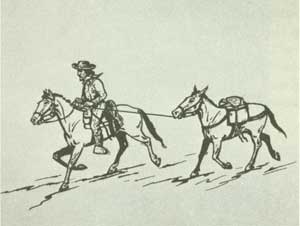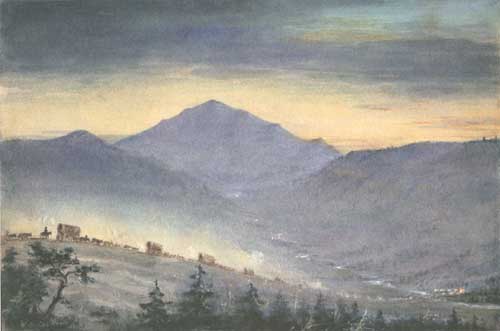
INTRODUCTION
By Marian Albright Schenk
FOREWORD
By Dean Knudsen
SECTION 1
Primary Themes of Jackson's Art
SECTION 2
Paintings of the Oregon Trail
SECTION 3
Historic Scenes From the West
 |
| These six desperados are actually members of the 1875 U.S. Geological Survey team, which explored the Southwest. William Henry Jackson is the third from the left. (SCBL 669) |

Section 2: Paintings of the Oregon Trail
FOOTHILLS OF THE ROCKIES
After leaving Fort Laramie, the freight wagons continued to follow the south bank of the Platte River. But the landscape was changing and there was a noticeable increase in the road's grade. They were climbing ever higher and the reason for this was becoming all too obvious. In the distance was a dark mountain range, and the wagon train was headed straight for it.
In those days, those mountains were referred to as "the Black Hills" and ought not be confused with the South Dakota mountains of the same name. Today, they are known as the Laramie Range, and they are considered to be the first foothills to the Rocky Mountains. On Thursday, August 9, 1866, Jackson made the following notation in his diary:
The roads are beginning to be terribly rocky & stony There are some awful pitches and it is a wonder we don't all smash up. . . Had two bad breaks today that delayed us two or three hours.1
 |
| In 1873, a mule named Gimlet, who Jackson described as "evil" slipped his pack and broke several glass plate negatives. Undaunted, Jackson simply retraced his steps and re-photographed those lost scenes. (SCBL 92) |
The next day the wagon master had to make an important decision. A new route, known as the Bozeman Trail, had just been opened which turned north and passed through Wyoming's Powder River country on its way to Virginia City in Montana. This route was much shorter, but it also had a much higher risk of encountering Sioux war parties. Jackson agreed wholeheartedly with the wagon master's conservative decision to stick with the longer but safer route through Salt Lake City.
By Saturday August 10th, the slow-moving wagons reached the mountains and the going got even tougher. Jackson continued:
Crossed the eastern slope of the Black Hills in the morning & had a fearfully hard pull up a steep hill and over a ridge. Pulled out again in p.m. and reached springs at the foot of a steep hill.2
The next day the trail became so steep that a special effort had to be made to haul the wagons through the hills.
Doubled up teams and pulled up to the top of the hill where we unyoked and got breakfast. Made a sketch of Laramie Peak that has been in sight for a week or two past. In the p.m. made a long and hard drive over the hills to La Bonta. It was quite dark & it is a wonder that more accidents did not occur.3
Although Jackson's sketch of Laramie Peak does not seem to have survived, his painting of the forbidding Black Hills with the tiny wagons slowly making their way down the steep slopes near La Bonte Creek, captures the rugged terrain and imminent danger that the young teamster experienced so many years before.
1. Hafen, Jackson Diaries, 63-64.
2. Ibid., 65.
3. Ibid., 65-66.
 |
| LaBonte Creek. Signed and dated 1939. 23.5 x 36.9 cm. (SCBL 30) |
 |
scbl/knudsen/sec2l.htm Last Updated: 14-Apr-2006 |
 |